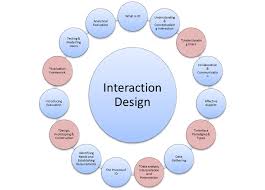The Power of Interactive Design
Interactive design is a dynamic and engaging field that has revolutionised the way we experience digital content. It goes beyond static visuals and allows users to actively engage with websites, apps, and other digital platforms. Through thoughtful design and strategic implementation, interactive design enhances user experience, encourages exploration, and fosters meaningful interactions.
Engaging User Experience
One of the key benefits of interactive design is its ability to create immersive and engaging user experiences. By incorporating interactive elements such as animations, transitions, clickable buttons, and responsive interfaces, designers can captivate users and guide them through a seamless digital journey. This not only keeps users interested but also encourages them to explore further.
Fostering Meaningful Interactions
Interactive design enables users to interact with content in a more personalised and meaningful way. Whether it’s through interactive infographics, interactive storytelling, or gamified experiences, users can actively participate in the content they consume. This level of engagement not only makes the experience more enjoyable but also enhances retention and understanding of information.
Enhancing Brand Identity
From playful micro-interactions to sophisticated user interfaces, interactive design plays a crucial role in shaping a brand’s identity online. By incorporating interactive elements that align with brand values and aesthetics, designers can create memorable experiences that resonate with users. Consistent use of interactive design can help establish brand recognition and differentiate a brand from its competitors.
The Future of Interactive Design
As technology continues to evolve, the possibilities for interactive design are limitless. From virtual reality experiences to voice-activated interfaces, designers are constantly exploring new ways to engage users through interactivity. The future of interactive design holds exciting opportunities for innovation and creativity across various industries.
In conclusion, interactive design is not just about creating visually appealing websites or apps; it’s about crafting experiences that connect with users on a deeper level. By leveraging the power of interactivity, designers can transform digital interactions into memorable moments that leave a lasting impression.
Understanding Interactive Design: Key Principles, Tools, and Business Benefits
- What is interactive design and how does it differ from traditional design?
- What are the key principles of interactive design?
- How does interactive design enhance user experience?
- What tools and software are commonly used in interactive design?
- How can businesses benefit from incorporating interactive design into their digital strategies?
What is interactive design and how does it differ from traditional design?
Interactive design is a dynamic approach to creating digital experiences that actively engage users through interactive elements such as animations, clickable buttons, and responsive interfaces. Unlike traditional design, which focuses on static visuals, interactive design prioritises user engagement and participation. By allowing users to interact with content in a more personalised and immersive way, interactive design enhances user experience and fosters meaningful interactions. This shift from passive consumption to active engagement sets interactive design apart from traditional design practices, offering a more dynamic and engaging digital experience for users.
What are the key principles of interactive design?
When delving into the realm of interactive design, one frequently asked question revolves around the key principles that underpin this dynamic field. The essence of interactive design lies in creating user-centric experiences that are intuitive, engaging, and purposeful. Key principles include usability, interactivity, feedback, simplicity, consistency, and visual hierarchy. Usability ensures that the design is easy to navigate and understand for users of all levels. Interactivity encourages user engagement and participation through clickable elements and animations. Feedback mechanisms provide users with clear responses to their actions. Simplicity in design helps streamline user interactions and reduce cognitive load. Consistency ensures a cohesive experience across different touchpoints. Lastly, visual hierarchy guides users through content by prioritising information effectively. Embracing these principles empowers designers to craft interactive experiences that resonate with users and drive meaningful interactions.
How does interactive design enhance user experience?
Interactive design enhances user experience by creating dynamic and engaging digital environments that invite users to actively participate and explore. By incorporating interactive elements such as animations, responsive interfaces, and intuitive navigation, interactive design empowers users to interact with content in a meaningful way. This not only makes the user experience more enjoyable but also fosters a sense of connection and immersion. Through thoughtful design and strategic implementation of interactive features, designers can guide users through a seamless digital journey, leading to increased engagement, retention, and overall satisfaction with the product or platform.
What tools and software are commonly used in interactive design?
In the realm of interactive design, a frequently asked question revolves around the tools and software commonly used by designers to bring their interactive creations to life. Designers often rely on a diverse range of tools such as Adobe Creative Suite (including Adobe XD, Photoshop, and Illustrator), Sketch, Figma, InVision Studio, and Axure RP for prototyping, wireframing, and creating interactive interfaces. These software packages provide designers with the necessary features and capabilities to design engaging user experiences, test prototypes, and collaborate effectively with team members throughout the interactive design process. By mastering these tools, designers can unleash their creativity and craft innovative digital experiences that captivate audiences.
How can businesses benefit from incorporating interactive design into their digital strategies?
Incorporating interactive design into their digital strategies can offer businesses a multitude of benefits. By embracing interactive elements such as engaging animations, intuitive interfaces, and interactive storytelling, businesses can enhance user engagement and create memorable experiences for their audience. This not only helps in capturing users’ attention but also encourages them to explore further and interact with the brand on a deeper level. Interactive design can also improve brand perception, differentiate businesses from competitors, increase user retention, and ultimately drive conversions and loyalty. Overall, integrating interactive design into digital strategies allows businesses to stand out in a crowded digital landscape and build stronger connections with their target audience.
